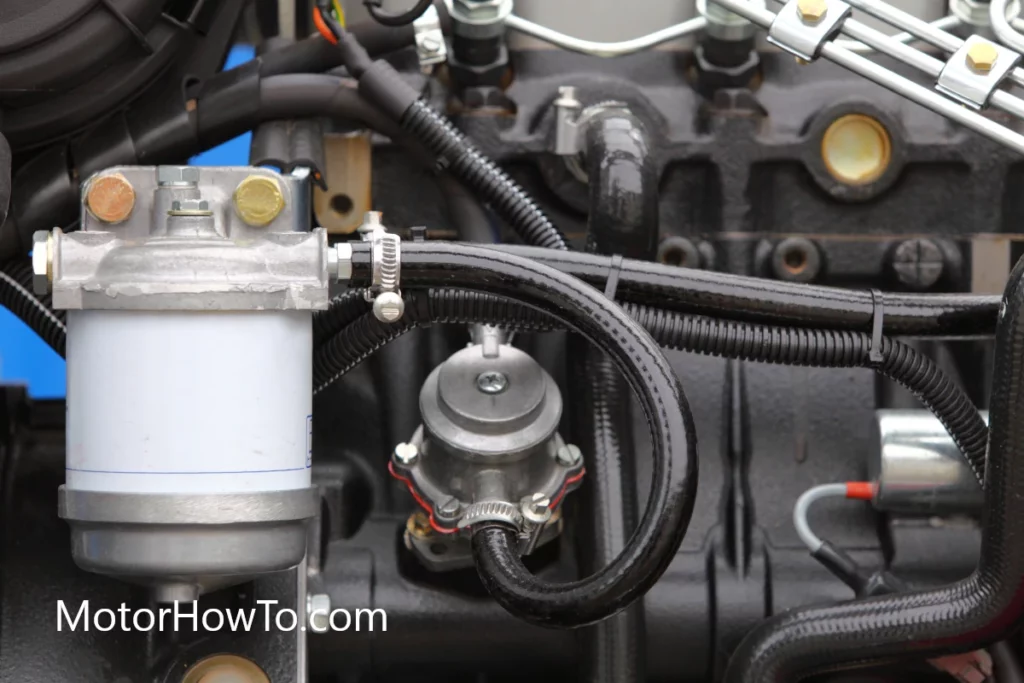In the world of diesel engines, few things can be as perplexing as encountering an unfamiliar diagnostic code.
For those who are both novices and experts in automotive mechanics, untangling the mysteries of these codes can be a formidable challenge. Specifically, when it comes to the 6.0 Powerstroke, there’s one code that has generated its fair share of head-scratching.
The P0460 code in a 6.0 Powerstroke pertains to a “Fuel Level Sensor Circuit Malfunction,” suggesting an irregularity with the sensor’s signal. To troubleshoot this, one should inspect the wiring for any damage, evaluate the condition of the fuel level sensor, ensure the fuel tank and its float are functioning properly, and examine the ECM for potential discrepancies.

Let’s dive deeper into what this elusive code means and how to approach it with a logical, troubleshooting mindset.
Related:
- Hydra Tuner 7.3 Problems (Common Issues Solved)
- HSP vs WCFAB (Which Delivers Superior Turbo Performance?)
- Fleece Cheetah vs Stealth 64 (Detailed Turbocharger Face-off)
What is the P0460 Code?
The P0460 code is a standard OBD-II (On-Board Diagnostics II) trouble code that signifies a discrepancy or malfunction within the fuel level sensor circuit.
This sensor is responsible for monitoring the amount of fuel present in a vehicle’s fuel tank.
When the vehicle’s powertrain control module (PCM) detects an irregular signal from the sensor compared to the actual fuel conditions or other engine readings, it triggers the P0460 code.
Several factors can give rise to this code. These can range from a genuine low or fluctuating fuel level to faulty electrical connections in the sensor circuit.
Additionally, a malfunctioning fuel sensor, issues with the float inside the fuel tank, or even a compromised PCM can lead to the activation of this code. Addressing the root cause is crucial to ensure the proper functioning of the vehicle and avoid potential fuel-related issues.
Understanding Fuel Level Sensor Circuit Malfunction
The fuel level sensor circuit is a crucial component in modern vehicles, playing an essential role in informing the driver about the amount of fuel left in the tank. Understanding its malfunction involves delving into its function and the potential issues that can compromise its performance.
The fuel level sensor, often inside the fuel tank, typically consists of a float attached to a potentiometer (variable resistor). As the fuel level rises or falls, the float moves, causing the resistance in the potentiometer to change.
This change in resistance translates to a voltage signal that varies according to the fuel level. The vehicle’s powertrain control module (PCM) or engine control module (ECM) receives this voltage signal and determines the fuel amount in the tank based on its value.
The information is then relayed to the fuel gauge on the dashboard, providing the driver with a visual representation of the fuel quantity remaining.
Potential Malfunctions:
When a “Fuel Level Sensor Circuit Malfunction” is detected, it typically means there’s a discrepancy between the signal from the fuel level sensor and the actual fuel conditions or other engine readings.
This mismatch can be attributed to several factors:
- Faulty Fuel Level Sensor: The sensor may wear out or get damaged over time, leading to inaccurate readings.
- Electrical Issues: Damaged wires, poor connections, or corroded connectors in the sensor circuit can interrupt the signal.
- Compromised Float: If the float in the fuel tank becomes waterlogged or damaged, it may not rise or fall accurately with the fuel level.
- PCM/ECM Problems: Rarely, the issue might lie with the PCM or ECM misinterpreting the signal from the sensor.
Addressing a malfunction involves pinpointing the specific issue through diagnostics and undertaking the necessary repairs or replacements.
Properly functioning fuel level sensor circuits ensure drivers are well-informed about their fuel status and prevent potential fuel and engine-related problems.
Step-by-Step Troubleshooting Tips:
1. Checking the Wiring System:
- Visual Inspection: Begin by visually inspecting the wiring that connects the fuel level sensor to the PCM. Look for obvious signs of damage, fraying, or corrosion.
- Use a Multimeter: With a multimeter, check the continuity of the wires. A broken wire will not show continuity. Also, test for any short circuits by checking resistance levels; they should align with standard specifications.
- Check Connectors: Inspect the connectors for dirt, corrosion, or damage. Clean any corroded connectors and ensure they are securely attached.
2. Inspecting the Fuel Level Sensor:
- Access the Sensor: Depending on the vehicle, you might need to remove the rear seat or access the sensor underneath the vehicle. Always consult the vehicle’s manual for specific instructions.
- Visual Check: Look for any signs of damage or wear on the sensor.
- Resistance Test: Using a multimeter, test the sensor’s resistance. The resistance should change smoothly without spikes or drops as you move the float up and down.
3. Verifying the Fuel Tank and Float:
- Examine the Float: Access the float, usually part of the fuel level sensor assembly, and check if it’s damaged or waterlogged. A compromised float won’t move accurately with the fuel level.
- Check the Fuel Tank: Ensure no obstructions or debris inside the tank might interfere with the float’s movement.
4. Evaluating the Engine Control Module (ECM):
- Error Codes: Connect an OBD-II scanner to the vehicle’s diagnostic port. The scanner will provide specific codes if there are issues with the ECM. While P0460 relates to the fuel level sensor circuit, other codes may suggest ECM problems.
- Reset and Test: After addressing any other issues, reset the ECM by disconnecting the vehicle’s battery for several minutes or using an OBD-II scanner’s reset function. Then, drive the vehicle and check if the code reappears.
- Professional Assessment: If you suspect the ECM is faulty after other troubleshooting steps, consider seeking a professional’s advice. They can further diagnose and recommend if the ECM needs reprogramming or replacement.
Remember, safety comes first. When working with fuel systems or electrical components, always take necessary precautions, work in well-ventilated areas, and disconnect the battery when appropriate.
Importance of Timely Diagnosis and Repair
When it comes to vehicle malfunctions, especially those related to critical systems such as the fueling apparatus, time is of the essence.
Addressing issues promptly not only safeguards the vehicle’s performance but also ensures the safety and financial well-being of the owner.
Here’s why timely diagnosis and repair are crucial:
1. Prevention of Further Damage:
If left unchecked, a small issue can snowball into a significant problem.
For instance, a malfunctioning fuel level sensor might initially seem inconvenient.
However, it can lead to the driver being unaware of low fuel levels, potentially causing the vehicle to run out of fuel in inopportune situations or leading to fuel pump damage due to it operating without the lubrication and cooling of fuel.
2. Safety Concerns:
Driving a vehicle with unresolved issues can be hazardous. If drivers are unaware of the fuel levels due to a faulty sensor, they could end up stranded in dangerous or remote locations.
Moreover, if not addressed, electrical issues might lead to more severe complications like short circuits or fires.
3. Cost Savings:
Timely repairs often translate to cost savings in the long run. Addressing an issue in its early stages can prevent more extensive and expensive repairs later.
For instance, rectifying a minor wiring problem can save the owner from potentially having to replace an entire sensor or module later on.
4. Maintaining Vehicle Value:
A well-maintained vehicle commands a higher resale value. Addressing issues promptly and ensuring that the vehicle’s systems are in optimal working condition can be a selling point if the owner decides to trade in or sell the vehicle.
5. Environmental Responsibility:
A vehicle with faulty components can consume more fuel or operate inefficiently, increasing emissions. Addressing issues ensures the vehicle runs optimally, contributing to a smaller carbon footprint.
6. Peace of Mind:
Knowing that a vehicle is in its best condition provides peace of mind to the driver. It removes the uncertainty of potential breakdowns and ensures a smoother driving experience.
In conclusion, timely diagnosis and repair are not mere recommendations but essential practices for every vehicle owner. They ensure the vehicle’s longevity, safety, and efficient performance, making every drive a confident journey.
Maintaining a Healthy 6.0 Powerstroke
The 6.0 Powerstroke, introduced by Ford in 2003, was designed to be a more powerful and emission-compliant successor to its 7.3L predecessor.
Despite some initial challenges, the 6.0 Powerstroke can be a reliable and long-lasting powertrain with proper care and maintenance. Here are essential tips to ensure its optimal performance:
1. Regular Oil Changes:
The lifeblood of any engine, clean oil, is paramount for the 6.0 Powerstroke.
Regularly change the oil and oil filter at recommended intervals, using high-quality diesel-specific oil that meets the engine’s specifications.
2. Monitor Coolant System:
The 6.0 Powerstroke is particularly sensitive to coolant quality.
Use the correct type of coolant and consider a coolant filter to remove contaminants. Regularly check the coolant level and look for oil or fuel contamination signs.
3. Upgrade the EGR (Exhaust Gas Recirculation) System:
The EGR system in the 6.0 Powerstroke can be a common point of failure.
Consider upgrading to a more robust EGR cooler or, where legally permissible, delete the EGR system for improved reliability.
4. Air Filter Inspection and Replacement:
A clean air filter ensures optimal combustion and fuel efficiency. Inspect it regularly for clogs or damage and replace it when necessary.
5. Fuel Quality and Filtration:
High-quality diesel fuel reduces the risk of contaminants harming the engine or fuel system.
Regularly replace fuel filters and consider aftermarket filtration systems for added protection.
6. Transmission Care:
Maintain the transmission by checking its fluid regularly.
Ensure that it’s clean and at the correct level.
Change the transmission fluid and filter as recommended.
7. Regularly Check for Leaks:
Keep an eye out for oil, fuel, or coolant leaks.
Addressing leaks promptly can prevent more significant issues down the line.
8. Stay Updated with Software:
Ensure that the engine control module (ECM) software is up-to-date.
Manufacturers often release updates to rectify performance or emission issues.
9. Drive Responsibly:
While the 6.0 Powerstroke can handle heavy loads, driving responsibly is essential.
Avoid excessive idling and regularly give the engine a good run to clear out any soot or deposits.
10. Periodic Professional Inspection:
Have a diesel mechanic or specialist periodically inspect your 6.0 Powerstroke.
Their expertise can identify potential issues before they become significant problems.
By adhering to these maintenance guidelines and proactively addressing potential problems, owners can ensure that their 6.0 Powerstroke remains a reliable and efficient workhorse for years
Sources
https://www.thedieselstop.com/threads/error-code-p0460.194586/



